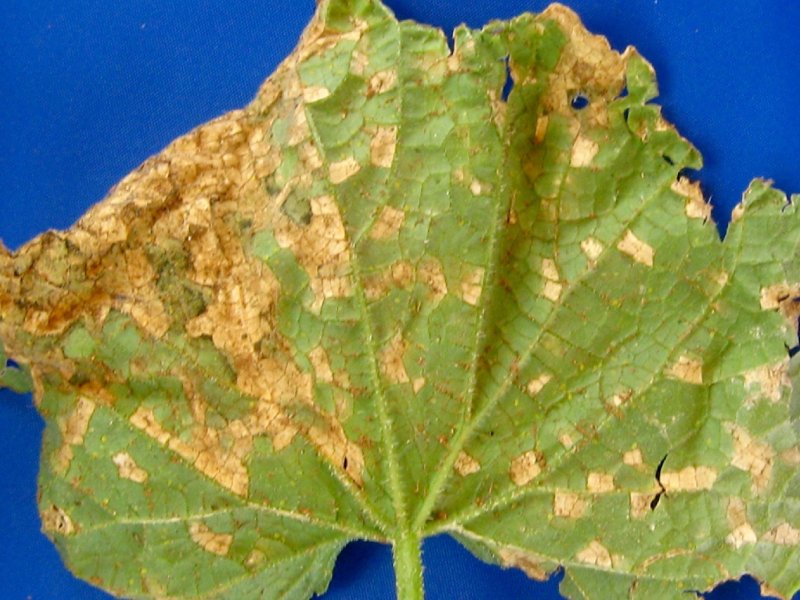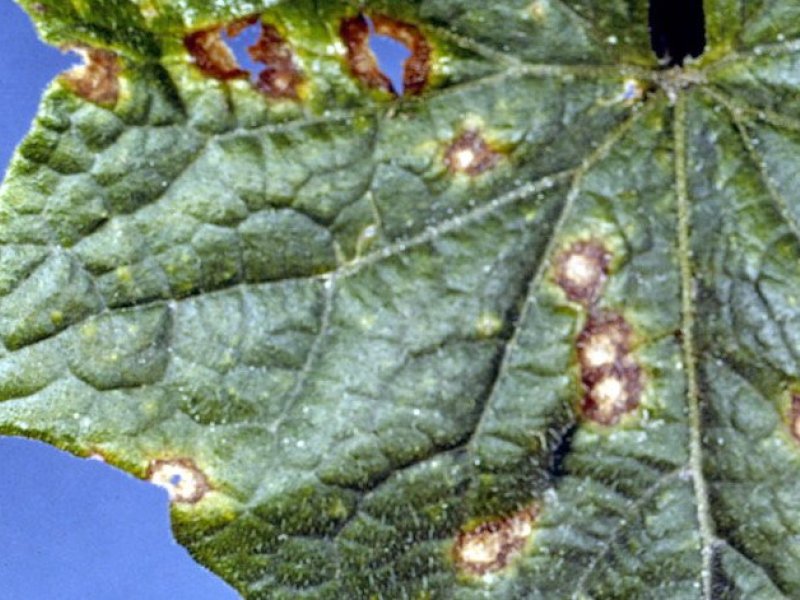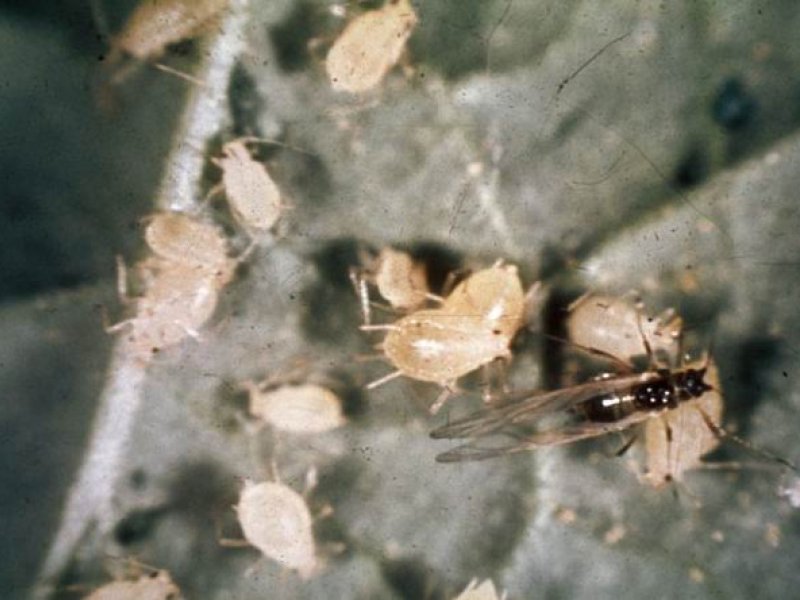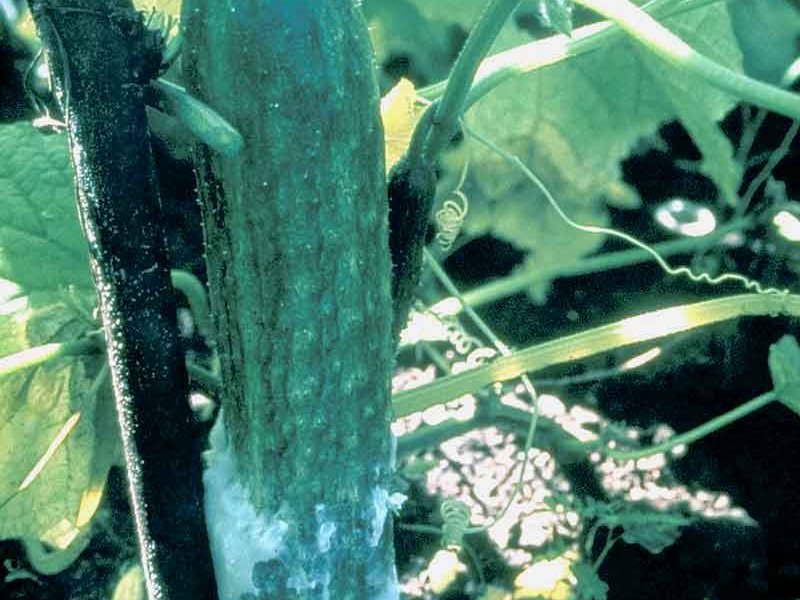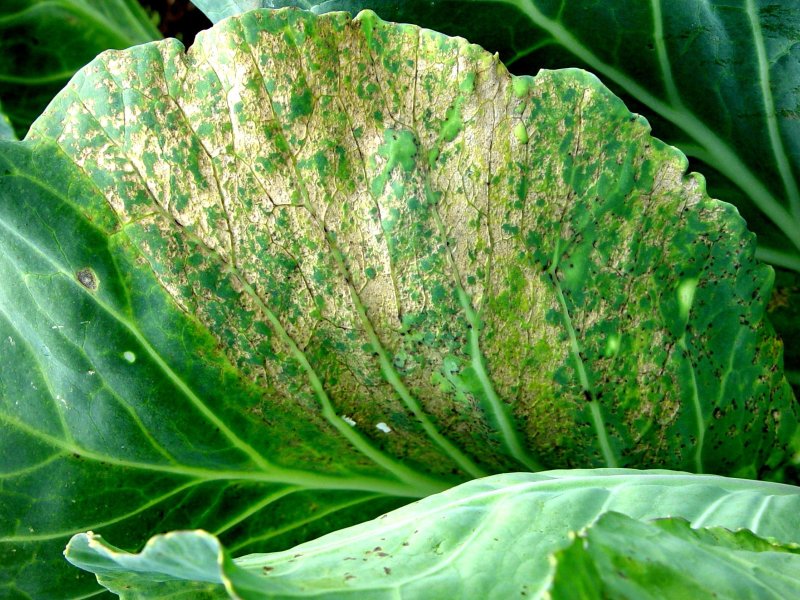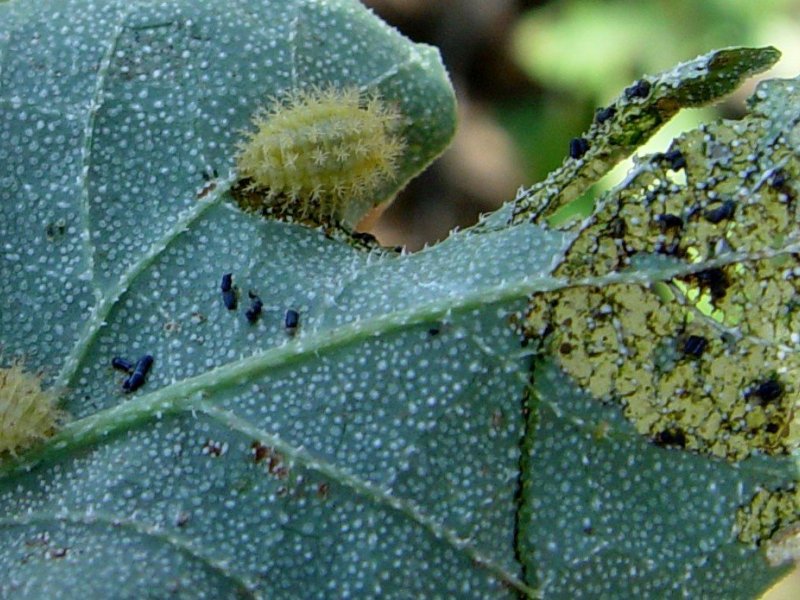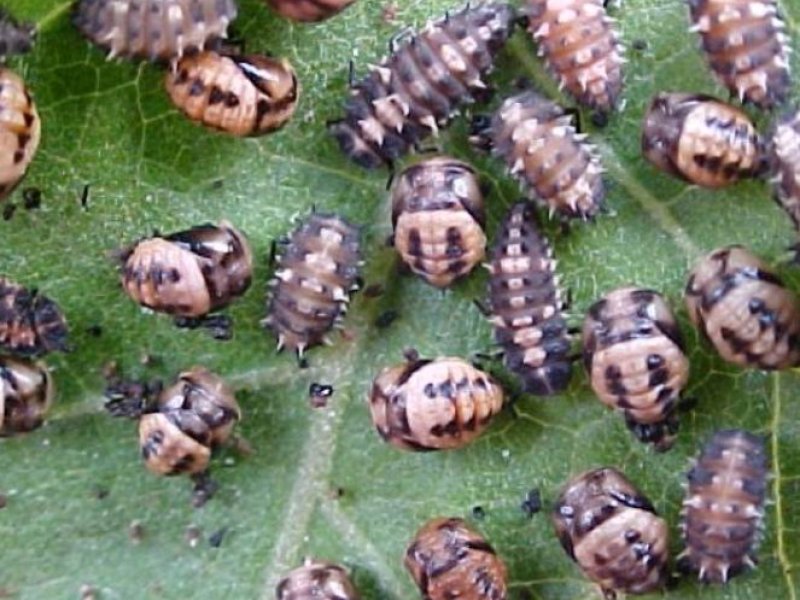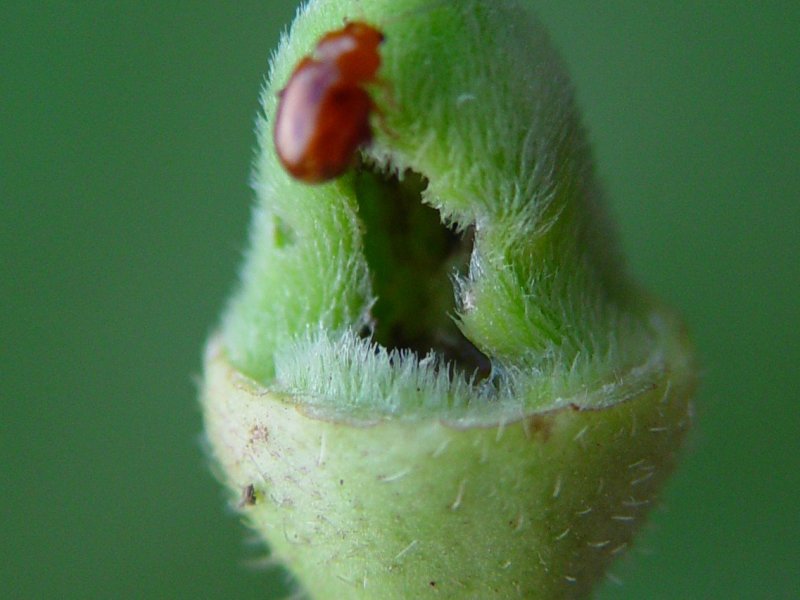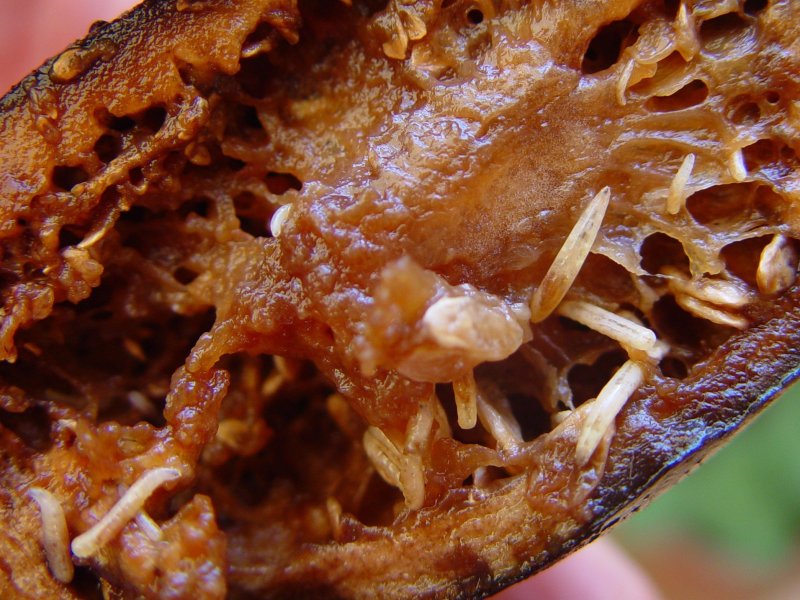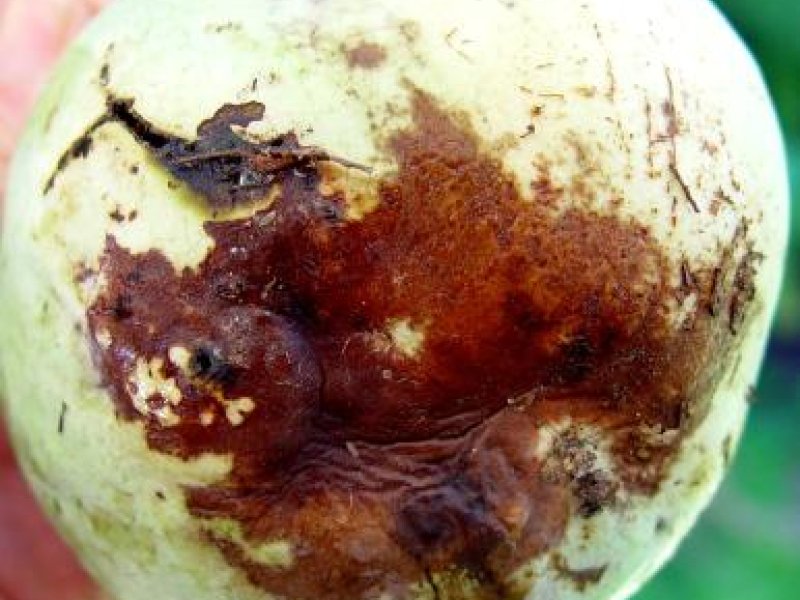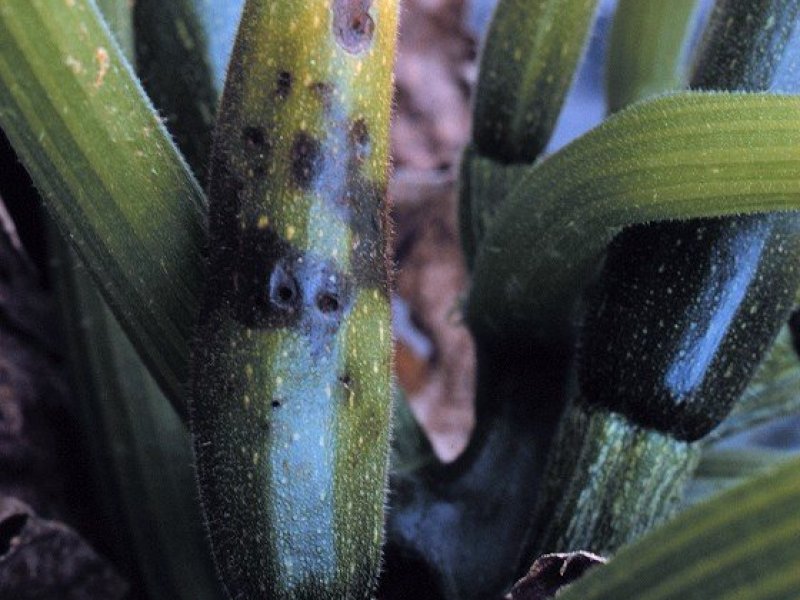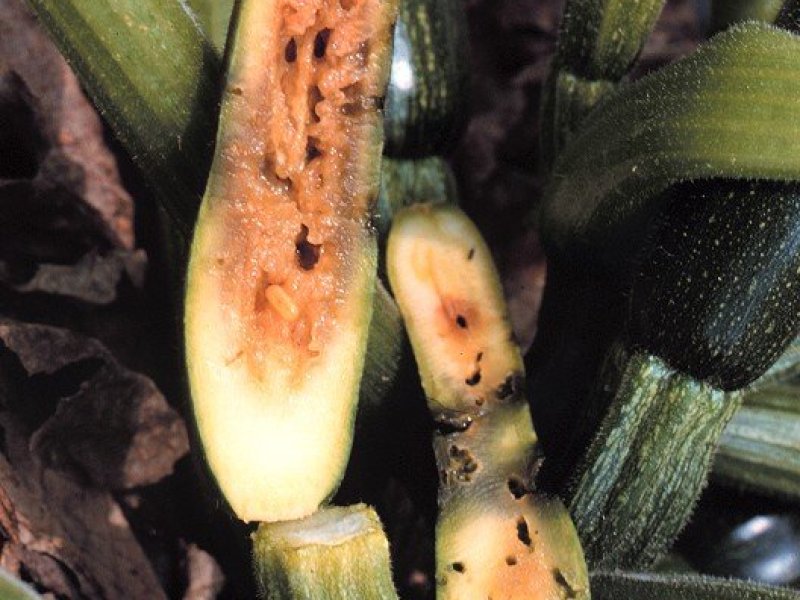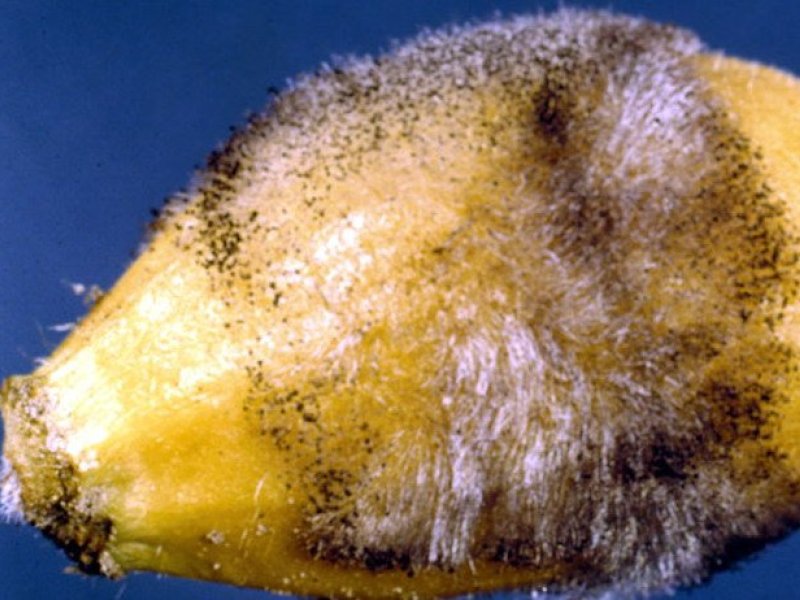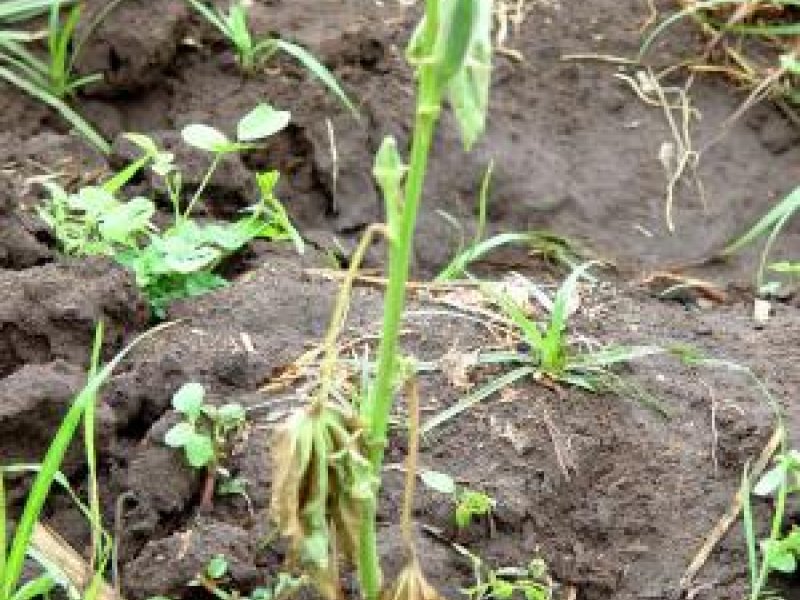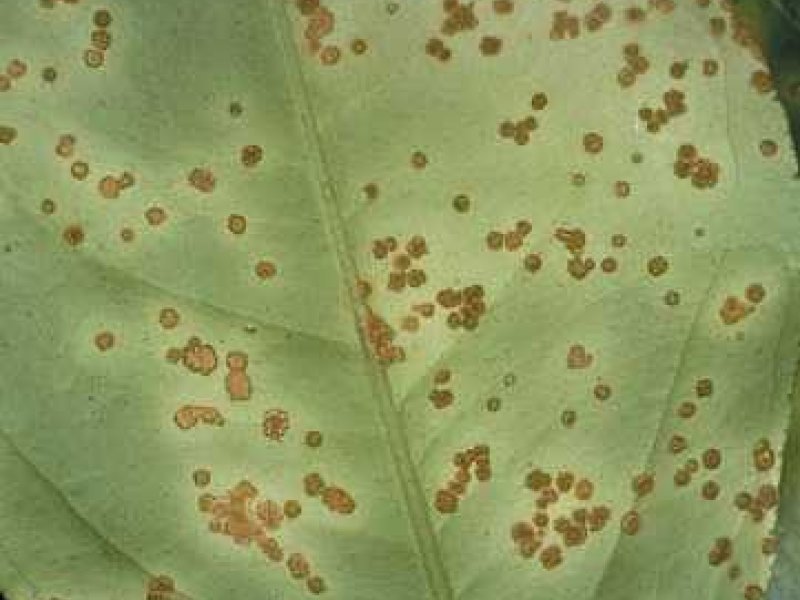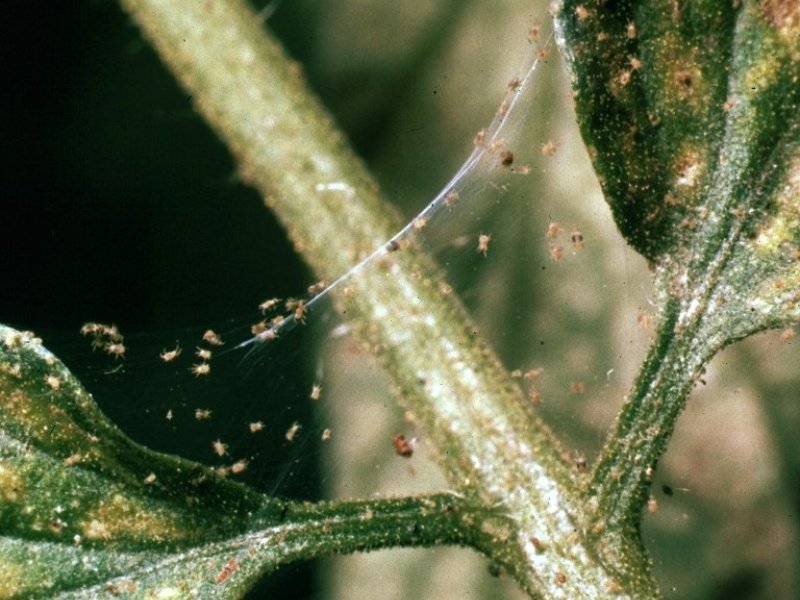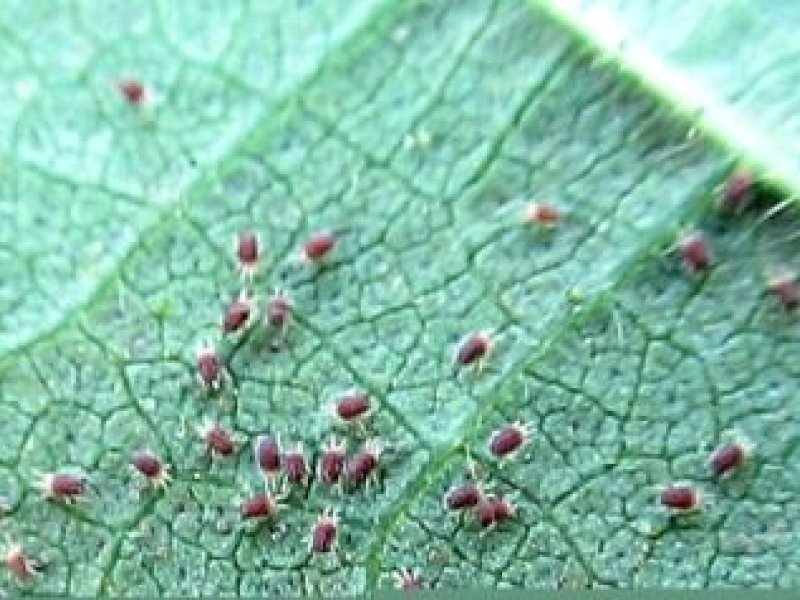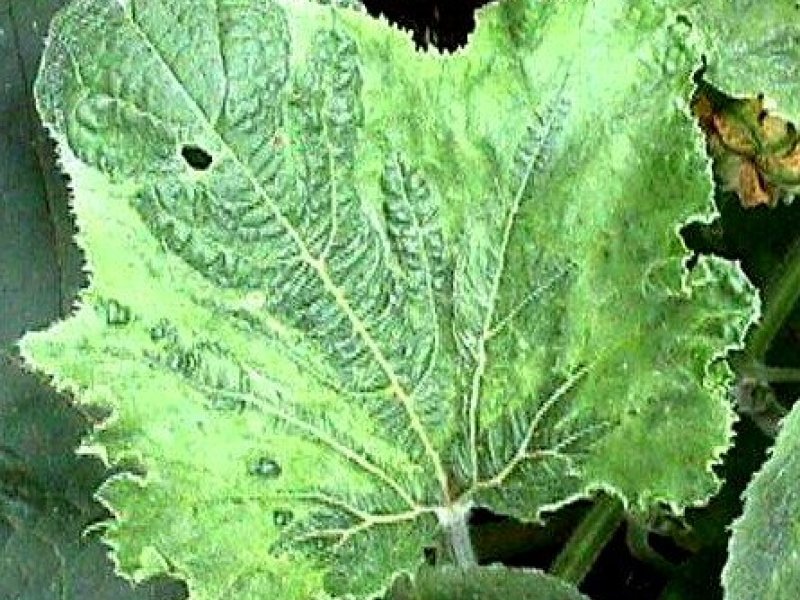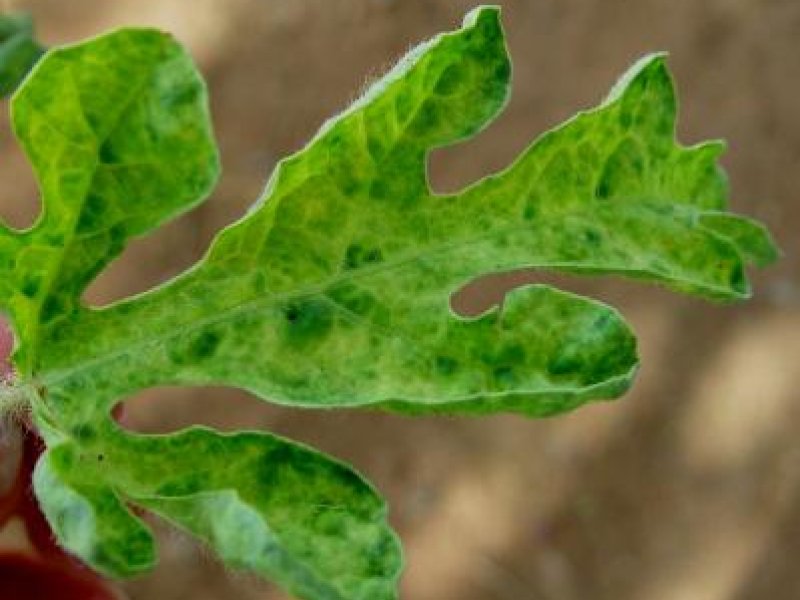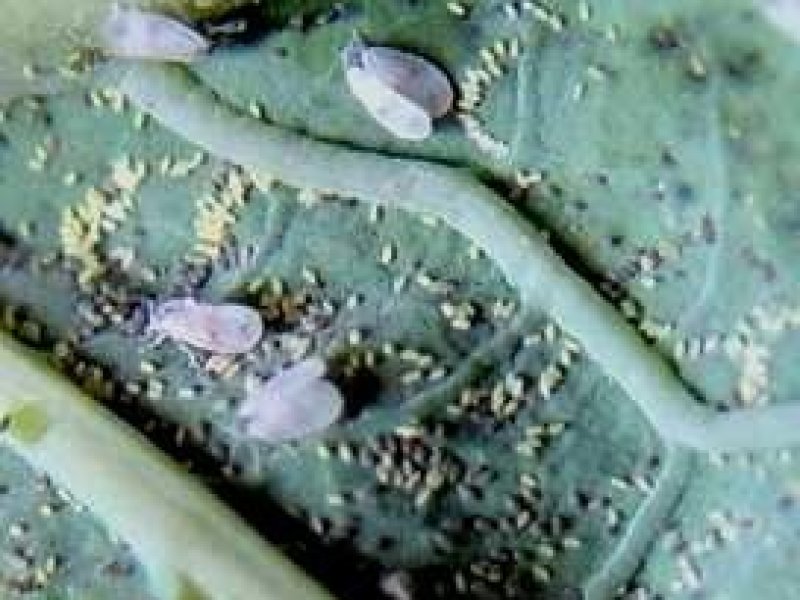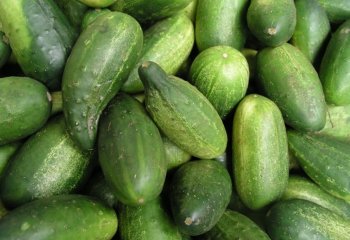|
Angular leaf spot (Pseudomonas syringae pv. lachrymans) Spots on leaves are angular in shape and variable in size due to leaf veins that limit their enlargement. Initially, spots are water-soaked. In moist weather, bacteria ooze from the spots in tear-like droplets, which dry making the tissue white. Affected leaf dries and shrinks, and it may tear away from the healthy portion leaving irregular holes. Leaves approaching maturity are more susceptible than older leaves. Fruits may also be attacked. Fruit spots are small, nearly circular and superficial. The bacteria survive in association with seed. When infected cucumbers are used for seed extraction, the seed can be contaminated during fermentation process. The bacteria can also survive in soil or infected crop debris. Drainage water can spread the bacteria in the soil. Angular leaf spot disease is favoured by wet conditions, frequently associated with rainfall and overhead irrigation. Optimum temperature for disease development is 23.9 to 27.8 degC. The disease attacks gherkin, muskmelon, pumpkin, squash, vegetable marrow and watermelon. |
|
|
What to do:
|
|
Anthracnose (Colletotrichum orbiculare) It is a very destructive disease. It causes defoliation and lesions on the fruits. The fungus can attack all the above-ground plant parts. Cotyledons (seed leaves) of affected seedlings droop and wilt. Lesions (elongated spots) may form on stems of affected seedlings near the ground. Spots on leaves start as small yellowish areas that enlarge and turn brown. The affected tissue dries, breaks and the whole leaf dies. On vines, the spots are elongated and may kill the vines. Symptoms are most noticeable on fruits. Spots on fruits are circular, black, and sunken. When wet, the centres of the spots become salmon coloured due to a mass of fungal spores. Affected fruits can be destroyed by secondary soft-rot organisms, which enter through broken rind. The fungus is seed-borne. It can survive in crop debris and in weeds belonging to the cucurbit family. Fungal development is promoted by wet conditions, high relative humidity and moderate temperatures (20 to 23.9°C ). Its host range includes cucumber, gherkin, gourd, muskmelon, and watermelon. Cucurbit weeds can also be attacked. |
|
|
What to do:
|
|
Aphids (Aphis gossypii) The cotton aphid (Aphis gossypii) is common on cucurbits, including cucumber. Colonies of green to blackish aphids are found on tender shoots, mainly on the lower leaf surface, where they suck sap. The growth of the attacked shoots is stunted and the leaves are curled and twisted. Aphids excrete honeydew, which leads to growth of sooty mould, and may attract fruit flies. Aphids, in particular winged aphids, transmit virus diseases (e.g. cucumber mosaic virus) when moving from plant to plant.
|
|
|
What to do:
|
|
Damping-off disease Damping-off diseases are caused by a complex of plant pathogens (disease inciting agents) including Alternaria spp., Fusarium spp., Pythium spp. and Rhizoctonia solani. These pathogenic fungi may cause rotting of seeds before emergence or death of seedlings after emergence. The most disposing factors are use of non-certified seeds and excessive watering of seed-beds or field plots. |
|
|
What to do:
|
|
Downy mildew (Pseudoperonospora cubensis) Symptoms on leaves appear as small, pale-yellow areas on upper leaf surface. Under humid conditions, a purplish, grey whitish growth may be seen on the underside of the yellowish spots. Affected leaves curl, shrivel and die. |
|
|
What to do:
|
|
Epilachna beetles (Epilachna chrysomelina) Adults of this beetle, also known as the African melon ladybird, are 6-8 mm long, reddish in colour with a number of black spots on the wing cases. The larvae are 7-9 mm in length, soft and covered with dark coloured spines. Adults and larvae feed on leaves leaving a fine net of veins. Damaged leaves shrivel and dry up. Young plants can be entirely destroyed. Older plants can tolerate considerable leaf damage. This beetle is a vector of squash mosaic virus. Epilachna beetles attack all cucurbits. |
|
|
What to do:
|
|
Flea beetles (Podagrica spp) They are 1.5 to 3 mm long with well-developed hind legs. They are named for their habit of jumping like fleas when disturbed. The colour of the adult beetles varies from black, brown, black and yellow striped or metallic blue-green depending on the species. Adult flea beetles chew small round holes (shot holes) in leaves, giving them a sieve like appearance. On rare occasions, they may feed directly on ripe fruit, just below the calyx. This damage is usually seen only in plants that show extreme foliar stress resulting from lack of water or powdery mildew. The larvae of flea beetles live in the soil and feed on roots, but the damage caused is not of economic importance. Adult flea beetles can be particularly damaging to young plants. Seedlings are most vulnerable to flea beetle feeding when stressed, particularly by inadequate moisture. Older plants can withstand considerable leaf perforation.
|
|
|
What to do:
|
|
Fruit flies (Bactrocera cucurbitae, Dacus spp and Ceratitis capitata) Fruit flies are important pests of cucumber and other cucurbits.
Fruit flies are about 4-7 mm long, they pierce the fruits and lay eggs in fruits. The fruit fly maggots feed inside the fruit causing sunken, discoloured patches, distortions and open cracks. These cracks serve as entry points for fungi and bacteria, causing fruit rot.
|
|
|
What to do:
|
|
Fruit rot Fruit rots are of minor importance in Africa; they are primarily post-harvest problems during storage. In most African countries, cucumbers are sold fresh from farm, consumed and are hardly stored for long (exception could be supermarkets in urban areas where fruits are kept on shelves).
|
|
|
What to do:
|
|
Fusarium wilt The lower leaves of the plant usually turn yellow and die. One or more branches may exhibit such symptoms. Leaflets on one side may be affected while those on the other side are symptomless. Diseased leaves readily break away from the stem. When affected stems just above ground level and petioles are cut diagonally, a reddish-brown discolouration of the water conducting tissues will be observed. The fungus is both seed- and soil-borne. It causes most damage on light, sandy soils. It is most active at temperatures between 25 and 320C. The fungus can survive in the soil indefinitely even when no tomatoes are grown. It can also survive in fibrous roots of weeds (e.g. Amaranthus, Digitaria and Malva species). Acidic soils (pH 5.0 to 5.6) and excessive nitrogen fertilisation promote disease development. Infestation by root-knot nematodes encourages the disease. |
|
|
What to do:
|
|
Root-knot nematodes (Meloidogyne spp.) Symptoms of infestation by root-knot nematodes are similar in all crops: wilting of plants and if infested plants are pulled from the soil the roots can be seen to be distorted, swollen and bearing knots. The infested roots eventually rot and affected plants die.
|
|
|
What to do:
|
|
Scab (Cladosporium cucumerinum) It attacks all aboveground plant parts. Initial symptoms on leaves appear as light water-soaked or pale green spots. The spots are numerous and can appear on and between veins. Elongate spots may develop on petioles and stems. The spots later turn grey to white and become angular. The fine veinlets in the spots may be brown and are distinct against a white background. Dead leaf tissue cracks and breaks away until the whole leaf is ragged. Fruits can be attacked at all stages of growth. However, young fruits are most susceptible. Plant tissue near the spots may produce sap, initially watery but later becomes gummy to hard. The fruit spots are cankerous and with time become darker, sunken until a pronounced cavity is formed. Under moist weather, a dark-green velvety layer of fungal growth appears on the cavities. The fungus survives in crop debris, soil and on seed. It is spread by insects, farm tools and wind. The disease is most severe at 100% relative humidity and at relatively cool temperatures (21-25°C). Its host range includes cantaloupe, gherkin, muskmelon, pumpkin, squash and watermelon.
|
|
|
What to do:
|
|
Red spider mites (Tetranychus spp.) Red spider mites attack leaves of cucumber. Adults are about 0.6 mm long. Attacked leaves have a stippled appearance, turn yellowish to whitish and dry up. Often young plants are entirely destroyed. In older plants growth can be severely stunted and the fruit set considerable reduced. Spider mites can be a problem in dry and hot conditions. Plants under water stress (drought) are more likely to suffer damage by spider mites. |
|
|
What to do:
|
|
Mosaic Virus diseases Cucumber mosaic virus It is not seed transmitted except through seed of perennial wild cucumber (Echinocytis lobata) and chickweed (Stellaria media). It is mechanically transmitted and in nature it is spread by various species of aphids. It has a very extensive host range including such varied species as bananas, carrots, cowpeas, lupine, lilies, onions, passion fruit, potatoes and tomatoes.
Watermelon mosaic virus This virus is mechanically transmitted and also spread by several species of aphids. It is not seed transmitted. Its host range is primarily restricted to cucurbits although one of its strains infects peas.
Squash mosaic virus It is mechanically transmitted. It is transmitted through seeds of melons and squash. It is also transmitted by spotted, striped and banded cucumber beetles, which attack cucumbers in the Americas. The Epilachna beetle (Epilachna chrysomelina) a pest of cucumber in Africa, is also vector of squash mosaic virus. Its host range includes cucurbits, peas, coriander, and salad chervil.
|
|
|
What to do:
|
|
Whiteflies (Bemisia tabaci) They suck plant sap and excrete honeydew where moulds grow, which may affect plant growth and vigour. The tobacco whitefly is considered a major pest due to its ability to vector various virus diseases, which cause considerable damage to cucurbits.
|
|
|
What to do:
|
Geographical Distribution in Africa
Geographical Distribution of Cucumber in Africa. Updated on 8 July 2019. Source FAOSTAT
© OpenStreetMap contributors, © OpenMapTiles, GBIF.
The cucumber is native to the region around the Himalayas south to Bangladesh and Thailand but is now grown worldwide.
General Information and Agronomic Aspects
Introduction
Cucumis sativus, commonly known as cucumber, is a widely cultivated plant belonging to the genus Cucumis and the family Cucurbitaceae. This family includes other important plants such as pumpkins, squash, gourds and zucchini. Cucumis is a diverse genus, comprising around 95 known species.
Cucumber is native to South Asia but is now cultivated worldwide. It is a warm-season annual vine that thrives in temperate and tropical regions. Cucumber plants have sprawling vines with large leaves and produce cylindrical fruits that can vary in size, shape, and color, depending on the variety. They are typically grown in gardens, greenhouses, and commercial farms.
Cucumber is mainly grown for the immature fruits, which are consumed fresh (slicing cucumber) in salads, sandwiches or used for pickles (pickling cucumber). The slicing cucumbers are peeled, sliced and served with vinegar or dressing, or as an ingredient of salads. The large, yellow, round types are boiled and eaten as an ingredient of stews. Pickling cucumbers are preserved or marinated with vinegar, salt, or spices.
Ⓒ Foods of the Nairobi people, 2005
Cucumbers are a good source of vitamin C. Cucumber's mild and refreshing flavour makes it a popular ingredient in various cuisines around the world, including Mediterranean, Asian, and Middle Eastern dishes. In many tropical African countries, cucumbers are considered exotic or Western vegetables. Southern African states however have their specific large type common in markets and used in local food preparations. They are primarily used by urban consumers. Cucumbers are low in calories and rich in water content, making them a hydrating and refreshing food choice. They are a good source of vitamins, including vitamin K and vitamin C, as well as minerals like potassium and magnesium. Cucumbers also contain antioxidants and phytonutrients that have been associated with potential health benefits, such as reducing inflammation and supporting digestion. They are also a good source of dietary fiber, which aids in digestion and promotes a healthy gut. The skin of cucumbers contains additional nutrients, so it is recommended to consume them with the peel whenever possible.
Ripe raw cucumber fruits are believed to have curative properties for sprue, and in Indo-China, cooked immature fruits are used to treat dysentery in children. The cucumber seeds have anthelmintic properties. Cucumber extract is known for its cleansing, soothing, and softening effects on the skin, making it a popular ingredient in various health and beauty products. Non-food uses of cucumber are not widespread in Africa.
(Van Luijk, M.N., 2004, Khan, A., et al., 2021, Maundu et al., 2007).
Species account
Cucumis sativus (cucumber) is an herbaceous, annual plant (surviving only one growing season) that typically grows in a trailing or climbing manner, with curling tendrils for support. Leaves: palmate and alternate in arrangement, deeply lobed with three to five lobes and have a rough texture. Leaves are typically green in color and have a rough surface due to small prickles. Flowers: produce both male and female flowers, usually yellow in color. Male flowers appear in clusters, while the female flowers are solitary and distinguishable by the presence of a small ovary at the base. Flowers are insect-pollinated and produce nectar to attract pollinators. Fruit: vary in size, shape, color and texture but is generally a curved cylindrical or elongated, although some varieties can be round or oval. The skin range from smooth to bumpy, and the color may vary from dark green to light green or even yellow. Some cultivars have a striped or mottled pattern on the skin. The flesh of the cucumber is crisp and juicy, containing numerous seeds. Seeds :ovate-oblong, compressed, white, smooth. Seedling with epigeal germination.
(Van Luijk, M.N., 2004. plantvillage.psu.edu)
Ⓒ Foods of the Nairobi people, 2005
Ⓒ Foods of the Nairobi people, 2005
Ⓒ Foods of the Nairobi people, 2005
Varieties.
The species Cucumis sativus displays significant variation, which has led to the development of numerous cultivars with different characteristics. Variations in fruit size, shape, color, taste, and disease resistance have been selected and bred by growers to meet specific consumer preferences and market demands. This variability within the species allows for a wide range of cucumber types to be grown and enjoyed worldwide.
Cucumber varieties are categorized into four types on basis of fruit length:
• Long cucumbers: Fruit length over 30 cm. Examples: "Berlin RZ", "Bologna RZ", "Cumlande RZ", "Myrthos RZ", "Pluto RZ" "Virginia RZ")
• Midi cucumbers: Fruit length between 18 -24 cm Examples: "Media RZ
• "Mini cucumbers: Fruit length between 15 -19 cm. Examples: "Khassib RZ", "Gianco RZ
• "Cocktail cucumbers: Less than 15 cm. Examples: "Rania RZ"
Other varieties include:
• "Ashley" It takes about 65 days to maturity. Fruit colour is dark green. Fruit shape is long and spined. It has some resistance to downy mildew.
• "Danora F1 Hybrid". It is a long cucumber. It tales about 65 days to maturity. Fruit colour is green. Fruit is elongated. It has good resistance to powdery mildew and leaf spot.
• "Palomar". It takes about about 60 days to maturity. Fruit is dark green. Fruit is long and cylindrical. It has good tolerance to leaf diseases. It is good for pickling.
• "Poinsett". Poinsett is a variety with a very high yield potential, good disease and heat resistance
• ."Sarig". It is dark green in colour. Fruit length of 14-16 cm. It is very smooth and of high quality. It has a long shelf life. It is resistant to powdery mildew. It is suitable for green house production.
• "Super Marketer". Maturity period is 45 to 60 days. It grows well in hot climatic conditions. Its very high yielding about 16-32 t/ha. It is very popular in the local market.
• "Tempo" ("HA 78"). It is dark green in colour. The average fruit length is 30-35 cm. It has a good shelf life of up to 2 weeks. It is resistant to powdery mildew.
• "Toaz". It has a very vigorous growth. Fruit is dark green in colour. Fruit length is 16-18 cm. It is smooth and has a good shelf life, It is suitable for green house production.
• "Long Fellow"
• "Hybrid Victory"
• "Kande" (new variety produced in Tanzania)
Because varieties change all the time, please ask your local seed company to give information about the available varieties.
Cucumber. © Biovision.
Marketable cucumbers: The two long varieties are greenhouse types that need protected environment and careful staking so as not to damage fruits. The two short types on the right can be grown in open fields and without staking. Pickling varieties are even smaller, but also baby fruits of the two field varieties are good for pickling.
Ecological conditions
Cucumber requires a warm climate. The optimum temperature for growth is about 30degC and the optimum night temperature 18-21degC. In the tropics, elevations up to 1700 m appear to be suitable for cucumber cultivation. A lot of light tends to increase the number of staminate (male) flowers. Cucumbers need a fair amount of water but they cannot stand waterlogging. High relative humidity encourages downy mildew. The soil should preferably be fertile and well-drained, with a pH of 6.5-7.5. Long and medium long slicing cucumber varieties are grown in greenhouses where climate and other growing conditions can be controlled.
Agronomic aspects
Cucumber is propagated by seed. Soil preparation requires generous incorporation of well-rotted manure. About 30 t/ha or 15 tons/ha should be applied inside the planting holes together with a spoonful of rock phosphate (3 tea spoons) for each planting hole. Sowing is done directly in the field with several seeds per hill, 90-120 cm apart, then thinned to 2-3 plants per hill, or seeds are sown in nursery beds and seedlings transplanted to the field at the 2-true-leaf stage at 30-40 cm within and 1-2 m between the rows. Sowing rates per ha are about 2.5-3 kg for direct seeding and 1 kg when transplanted. Cucumber cultivated for pickles is planted closer, up to 250,000 plants/ha. For greenhouse varieties plants are started in individual pots and transplanted to permanent position when they have 2-3 permanent leaves.
Husbandry
Weed control is necessary until the plants cover the soil entirely. Support (stakes) should be provided for some cultivars, and the tip of the main stem can be nipped off to encourage branching. Irrigate at frequent intervals, and maintain a high level of soil moisture throughout the growing period. Lateral shoots can be pruned after the first fruits have formed to limit leaf and flower production. Greenhouse varieties are staked according to preferred practices, usually by means of twisting the growing stem around a string attached to an overhead strong wire. There are indications that irrigation water containing applications of effective micro-organisms (EM) can prevent damping off and early attacks of diseases on leaves.
Irrigation should preferably be applied in the form of drip in order to prevent water splashes and spread of diseases. Staked cucumbers are very susceptible to wind, so if grown in open land should be carefully protected from wind.
Harvest, post-harvest practices and markets
Harvest
Cucumbers for fresh consumption are harvested before they are fully mature, usually starting about 50- 60 days after planting, and thereafter every few days. Mature fruits are yellow and the flesh is often tough with woody seeds. For pickling, immature fruits of several stages are harvested. Only for seed production are cucumbers allowed to mature on the plant.
Post-harvest practices
Cucumbers should be handled with care as they get damaged easily during transport. Depending on variety one plant may yield up to 10 fruits, and total yields with good plant care can easily reach 50 tons/ ha of the larger fruit types. More common yields are 25-30 tonnes/ha. Fruits should not be left to ripen on the vines as the plants will cease to bear. The marketed fruit must be firm, green and the size typical of the cultivar.
Some of the long slicing cultivars of cucumber are packed individually before marketing and cooled.
Value addition and markets
Common cucumber value addition methods include pickling, juicing, and using cucumber extracts in skincare products. Pickling cucumbers in vinegar or brine extends their shelf life and creates a tangy snack or side dish. Juicing or blending cucumbers into smoothies adds a refreshing and nutritious element to beverages.
Cucumbers are globally popular vegetables, top cucumber producers include China, Turkey, Iran, Russia, and the United States. These countries have substantial cucumber cultivation and supply to both domestic and international markets. The United States, European Union, Japan, and Southeast Asian countries are significant cucumber markets.
In Africa, cucumber cultivation is widespread, primarily for domestic consumption and local markets. Countries such as Nigeria, Egypt, South Africa, Kenya, and Morocco are notable cucumber producers. Cucumbers form an essential part of African diets and are used in various traditional dishes and salads. However, the export of cucumbers from Africa is relatively limited compared to major global producers. In recent years, there has been an increasing demand for fresh and organic produce globally, including cucumbers. Consumers are seeking healthier food choices, driving the popularity of cucumbers in salads and healthy beverages. Additionally, the rising trend of natural skincare products has boosted the demand for cucumber extracts in the cosmetic industry.
(Van Luijk, M.N., 2004. tridge.com)
Nutritional value and recipes
Cucumbers offer a versatile culinary diversity, making them a popular ingredient in various cuisines around the world. They can be enjoyed raw in salads, sandwiches, or as a refreshing side dish. In Mediterranean cuisine, cucumbers are often combined with yogurt to create tzatziki, a cooling sauce or dip. In East Asian cuisine, they are pickled or added to sushi rolls. Additionally, cucumbers can be juiced or blended into smoothies for a refreshing beverage.
Cucumbers are low in calories but high in vitamin C. Cucumbers are primarily composed of water, accounting for about 95% of their weight. This high water content helps to keep the body hydrated, especially during hot summer months. They also contain a variety of essential vitamins and minerals, including vitamin K, vitamin C, potassium, and magnesium, though in small quantities compared to green leafy vegetables. Cucumbers also contain antioxidants, including flavonoids and tannins, which prevent the accumulation of harmful free radicals and may reduce the risk of chronic disease.
One of the notable benefits of cucumbers is their potential to aid in weight management. Due to their low calorie and high water content, cucumbers are a filling snack that can help satisfy hunger cravings without adding excessive calories
(healthline.com, webmd.com/)
Approximate nutritional value for 100g of Cucumber, green, unpeeled, raw
|
Cucumber, green, unpeeled, raw |
Recommended daily allowance (approx.) for adultsa |
|
|
Edible conversion factor |
0.97 |
|
|
Energy (kJ) |
47 |
9623 |
|
Energy (kcal) |
11 |
2,300 |
|
Water (g) |
96.2 |
2000-3000c |
|
Protein (g) |
0.6 |
50 |
|
Fat (g) |
0.1 |
<30(male), <20 (female)b |
|
Carbohydrate available (g) |
1.3 |
225 -325g |
|
Fibre (g) |
1.4 |
30d |
|
Ash (g) |
0.5 |
|
|
Mineral composition |
|
|
|
Ca (mg) |
20 |
800 |
|
Fe (mg) |
0.7 |
14 |
|
Mg (mg) |
14 |
300 |
|
P (mg) |
20 |
800 |
|
K (mg) |
136 |
4,700f |
|
Na (mg) |
22 |
<2300e |
|
Zn (mg) |
0.18 |
15 |
|
Se (mcg) |
1 |
60 |
|
Bioactive compound composition |
|
|
|
Vit A RAE (mcg) |
0 |
800 |
|
Vit A RE (mcg) |
1 |
800 |
|
Retinol (mcg) |
0 |
1000 |
|
b-carotene equivalent (mcg) |
5 |
600 – 1500g |
|
Thiamin (mg) |
0.03 |
1.4 |
|
Riboflavin (mg) |
0.02 |
1.6 |
|
Niacin (mg) |
0.20 |
18 |
|
Dietary Folate Eq.(mcg) |
7 |
400 |
|
Vit B12 (mcg) |
0 |
3 |
|
Vit C (mg) |
7 |
60 |
Source (Nutrient data): FAO/Government of Kenya. 2018. Kenya Food Composition Tables. Nairobi, 254 pp. http://www.fao.org/3/I9120EN/i9120en.pdf
RE=retinol equivalents.
RAE =Retinol activity equivalents. A RAE is defined as 1μg all-trans-retinol, 12μg beta-carotene, or 24μg α-carotene or β-cryptoxanthin.
a Lewis, J. 2019. Codex nutrient reference values. Rome. FAO and WHO
b NHS (refers to saturated fat)
c https://www.hsph.harvard.edu/nutritionsource/water/
d British Heart Foundation
e FDA
f NIH
g Mayo Clinic
| The cotton aphid (Aphis gossypii) is common on cucurbits, including cucumber. Colonies of green to blackish aphids are found on tender shoots, mainly on the lower leaf surface, where they suck sap. The growth of the attacked shoots is stunted and the leaves are curled and twisted. Aphids excrete honeydew, which leads to growth of sooty mould, and may attract fruit flies. Aphids, in particular winged aphids, transmit virus diseases (e.g. cucumber mosaic virus) when moving from plant to plant.
What to do:
|
| Fruit flies (Bactrocera cucurbitae, Dacus spp and Ceratitis capitata) Fruit flies are important pests of cucumber and other cucurbits.
Fruit flies are about 4-7 mm long, they pierce the fruits and lay eggs in fruits. The fruit fly maggots feed inside the fruit causing sunken, discoloured patches, distortions and open cracks. These cracks serve as entry points for fungi and bacteria, causing fruit rot.
What to do:
|
| They suck plant sap and excrete honeydew where moulds grow, which may affect plant growth and vigour. The tobacco whitefly is considered a major pest due to its ability to vector various virus diseases, which cause considerable damage to cucurbits.
What to do:
|
| Epilachna beetles (Epilachna chrysomelina) Adults of this beetle, also known as the African melon ladybird, are 6-8 mm long, reddish in colour with a number of black spots on the wing cases. The larvae are 7-9 mm in length, soft and covered with dark coloured spines. Adults and larvae feed on leaves leaving a fine net of veins. Damaged leaves shrivel and dry up. Young plants can be entirely destroyed. Older plants can tolerate considerable leaf damage. This beetle is a vector of squash mosaic virus. Epilachna beetles attack all cucurbits. What to do:
|
| They are 1.5 to 3 mm long with well-developed hind legs. They are named for their habit of jumping like fleas when disturbed. The colour of the adult beetles varies from black, brown, black and yellow striped or metallic blue-green depending on the species. Adult flea beetles chew small round holes (shot holes) in leaves, giving them a sieve like appearance. On rare occasions, they may feed directly on ripe fruit, just below the calyx. This damage is usually seen only in plants that show extreme foliar stress resulting from lack of water or powdery mildew. The larvae of flea beetles live in the soil and feed on roots, but the damage caused is not of economic importance. Adult flea beetles can be particularly damaging to young plants. Seedlings are most vulnerable to flea beetle feeding when stressed, particularly by inadequate moisture. Older plants can withstand considerable leaf perforation.
What to do:
|
| Red spider mites (Tetranychus spp.) Red spider mites attack leaves of cucumber. Adults are about 0.6 mm long. Attacked leaves have a stippled appearance, turn yellowish to whitish and dry up. Often young plants are entirely destroyed. In older plants growth can be severely stunted and the fruit set considerable reduced. Spider mites can be a problem in dry and hot conditions. Plants under water stress (drought) are more likely to suffer damage by spider mites. What to do:
|
| Root-knot nematodes (Meloidogyne spp.) Symptoms of infestation by root-knot nematodes are similar in all crops: wilting of plants and if infested plants are pulled from the soil the roots can be seen to be distorted, swollen and bearing knots. The infested roots eventually rot and affected plants die.
What to do:
|
Information on Diseases
General Information
Many viruses affect the cucumber family. The important viruses include cucumber mosaic virus, watermelon mosaic virus and squash mosaic virus. Field symptoms of these three diseases are similar and therefore it is very difficult to separate them by symptoms alone. Leaf symptoms include a prominent light and green mosaic pattern, mottling (yellow with green islands or blisters), and in severe cases, leaf distortion whereby affected leaves appear fern-like. Diseased fruits are malformed (slightly to severely misshaped with wart-like lumps).
Examples of Cucumber Diseases and Organic Control Methods
| Damping-off diseases are caused by a complex of plant pathogens (disease inciting agents) including Alternaria spp., Fusarium spp., Pythium spp. and Rhizoctonia solani. These pathogenic fungi may cause rotting of seeds before emergence or death of seedlings after emergence. The most disposing factors are use of non-certified seeds and excessive watering of seed-beds or field plots. What to do:
|
| Downy mildew (Pseudoperonospora cubensis) Symptoms on leaves appear as small, pale-yellow areas on upper leaf surface. Under humid conditions, a purplish, grey whitish growth may be seen on the underside of the yellowish spots. Affected leaves curl, shrivel and die. What to do:
|
| Angular leaf spot (Pseudomonas syringae pv. lachrymans) Spots on leaves are angular in shape and variable in size due to leaf veins that limit their enlargement. Initially, spots are water-soaked. In moist weather, bacteria ooze from the spots in tear-like droplets, which dry making the tissue white. Affected leaf dries and shrinks, and it may tear away from the healthy portion leaving irregular holes. Leaves approaching maturity are more susceptible than older leaves. Fruits may also be attacked. Fruit spots are small, nearly circular and superficial. The bacteria survive in association with seed. When infected cucumbers are used for seed extraction, the seed can be contaminated during fermentation process. The bacteria can also survive in soil or infected crop debris. Drainage water can spread the bacteria in the soil. Angular leaf spot disease is favoured by wet conditions, frequently associated with rainfall and overhead irrigation. Optimum temperature for disease development is 23.9 to 27.8 degC. The disease attacks gherkin, muskmelon, pumpkin, squash, vegetable marrow and watermelon. What to do:
|
| Anthracnose (Colletotrichum orbiculare) It is a very destructive disease. It causes defoliation and lesions on the fruits. The fungus can attack all the above-ground plant parts. Cotyledons (seed leaves) of affected seedlings droop and wilt. Lesions (elongated spots) may form on stems of affected seedlings near the ground. Spots on leaves start as small yellowish areas that enlarge and turn brown. The affected tissue dries, breaks and the whole leaf dies. On vines, the spots are elongated and may kill the vines. Symptoms are most noticeable on fruits. Spots on fruits are circular, black, and sunken. When wet, the centres of the spots become salmon coloured due to a mass of fungal spores. Affected fruits can be destroyed by secondary soft-rot organisms, which enter through broken rind. The fungus is seed-borne. It can survive in crop debris and in weeds belonging to the cucurbit family. Fungal development is promoted by wet conditions, high relative humidity and moderate temperatures (20 to 23.9°C ). Its host range includes cucumber, gherkin, gourd, muskmelon, and watermelon. Cucurbit weeds can also be attacked. What to do:
|
| The lower leaves of the plant usually turn yellow and die. One or more branches may exhibit such symptoms. Leaflets on one side may be affected while those on the other side are symptomless. Diseased leaves readily break away from the stem. When affected stems just above ground level and petioles are cut diagonally, a reddish-brown discolouration of the water conducting tissues will be observed. The fungus is both seed- and soil-borne. It causes most damage on light, sandy soils. It is most active at temperatures between 25 and 320C. The fungus can survive in the soil indefinitely even when no tomatoes are grown. It can also survive in fibrous roots of weeds (e.g. Amaranthus, Digitaria and Malva species). Acidic soils (pH 5.0 to 5.6) and excessive nitrogen fertilisation promote disease development. Infestation by root-knot nematodes encourages the disease. What to do:
|
| Fruit rots are of minor importance in Africa; they are primarily post-harvest problems during storage. In most African countries, cucumbers are sold fresh from farm, consumed and are hardly stored for long (exception could be supermarkets in urban areas where fruits are kept on shelves).
What to do:
|
| Cucumber mosaic virus It is not seed transmitted except through seed of perennial wild cucumber (Echinocytis lobata) and chickweed (Stellaria media). It is mechanically transmitted and in nature it is spread by various species of aphids. It has a very extensive host range including such varied species as bananas, carrots, cowpeas, lupine, lilies, onions, passion fruit, potatoes and tomatoes.
Watermelon mosaic virus This virus is mechanically transmitted and also spread by several species of aphids. It is not seed transmitted. Its host range is primarily restricted to cucurbits although one of its strains infects peas.
Squash mosaic virus It is mechanically transmitted. It is transmitted through seeds of melons and squash. It is also transmitted by spotted, striped and banded cucumber beetles, which attack cucumbers in the Americas. The Epilachna beetle (Epilachna chrysomelina) a pest of cucumber in Africa, is also vector of squash mosaic virus. Its host range includes cucurbits, peas, coriander, and salad chervil.
What to do:
|
| Scab (Cladosporium cucumerinum) It attacks all aboveground plant parts. Initial symptoms on leaves appear as light water-soaked or pale green spots. The spots are numerous and can appear on and between veins. Elongate spots may develop on petioles and stems. The spots later turn grey to white and become angular. The fine veinlets in the spots may be brown and are distinct against a white background. Dead leaf tissue cracks and breaks away until the whole leaf is ragged. Fruits can be attacked at all stages of growth. However, young fruits are most susceptible. Plant tissue near the spots may produce sap, initially watery but later becomes gummy to hard. The fruit spots are cankerous and with time become darker, sunken until a pronounced cavity is formed. Under moist weather, a dark-green velvety layer of fungal growth appears on the cavities. The fungus survives in crop debris, soil and on seed. It is spread by insects, farm tools and wind. The disease is most severe at 100% relative humidity and at relatively cool temperatures (21-25°C). Its host range includes cantaloupe, gherkin, muskmelon, pumpkin, squash and watermelon.
What to do:
|
References and information links
References
- AIC, Nairobi (2003). Fruits and Vegetables Technical Handbook
- AVRDC International Cooperators' Factsheet on Cucurbits www.avrdc.org
- Beije, C.M., Kanyangia, S.T., Muriuki, S.J.N., Otieno, E.A., Seif, A.A., Whittle, A.M. (1984). Horticultural Crops Protection Handbook.National Horticultural Research Station, Thika KEN/75/028 and KEN/80/017/
- Blay, E., Cudjoe, A. R., Braun, M. (Editors) (2000). Handbook of crop protection recommendations in Ghana: An IPM approach. Vol 2; vegetables. Plant Protection & Regulatory Services Directorate (PPRSD) and the Integrated Crop Protection Project, German Development Cooperation (GTZ).
- Bohlen, E. (1973). Crop pest in Tanzania and their control. Federal Agency for Economic Cooperation (BFE). Veralgh Paul Parey. ISBN 3-489-64826-9
- CAB International (2005). Crop Protection Compendium, 2005 Edition. Wallingford, UK www.cabi.org
- East African Seed Co. Ltd. Africa's Best Grower's Guide www.easeed.com
- Ekesi, S., Billah, M.K. (Eds) (2006). A field guide to the management of economically important tephritid fruit flies in Africa. ICIPE. ISBN: 92-9064-179-7
- Khan, A., Mishra, A., Hasan, S. M., Usmani, A., Ubaid, M., Khan, N., & Saidurrahman, M. (2021). Biological and medicinal application of Cucumis sativus Linn.–review of current status with future possibilities. Journal of Complementary and Integrative Medicine, 19(4), 843-854.
- Kuepper, G. (2003). Flea Beetle: Organic Control Options. NCAT Agriculture Specialist. Published ATTRA Publication #CT114. National Sustainable Agriculture Information Service.
- Ministry of Agriculture and Rural Development (Kenya) (MoARD) & Japan International Cooperation Agency (JICA) (2000). Local and Export Vegetables Growing Manual. Reprinted by Agricultural Information Resource Centre, Nairobi, Kenya. 274 pp.
- Nutrition Data www.nutritiondata.com.
- Ostermann, H., Dreyer, M. (1995). Vegetables and grain legumes. In "The Neem tree Azadirachta indica A. Juss. and other meliaceous plants sources of unique natural products for integrated pest management, industry and other purposes". Edited by H. Schmutterer in collaboration with K. R. S. Ascher, M. B. Isman, M. Jacobson, C. M. Ketkar, W. Kraus, H. Rembolt, and R.C. Saxena. VCH. pp. 392-403. ISBN: 3-527-30054-6
- Royal Botanic Gardens, Kew. (2023). Plants of the World Online. Retrieved May 26, 2023, from https://powo.science.kew.org/taxon/urn:lsid:ipni.org:names:292296-1
- Sherf, A.F., Macnab, A.A.(A.A. (1986). Vegetable Diseases and Their Control. 2nd. Edition. John Wiley & Sons Inc. USA. ISBN: 0-471-05860-2
- Summers, C.G. and Stapleton, J. J. (2002). Use of UV reflective mulch to delay the colonization and reduce the severity of Bemisia argentifolii (Homoptera: Aleyrodidae) infestations in cucurbits. Crop Protection. Volume 21. Pages 921-928.www.sciencedirect.com
- UCANR. UC helps pumpkin farmers produce pumpkins without pesticides. October 2003. www.ucanr.org
- van Luijk, M.N., 2004. Cucumis sativus L. [Internet] Record from PROTA4U. Grubben, G.J.H. & Denton, O.A. (Editors). PROTA (Plant Resources of Tropical Africa / Ressources végétales de l’Afrique tropicale), Wageningen, Netherlands. Accessed 30 July 2023.
Information links
• https://specialtyproduce.com/produce/Cucumbers_385.php
• https://www.researchgate.net/figure/Top-eight-producers-of-cucumbers-fresh-and-processed-in-the-world_tbl1_311840374
• https://www.newsnetmedia.com/story/48183798/cucumis
• https://www.healthline.com/nutrition/7-health-benefits-of-cucumber#TOC_TITLE_HDR_3
• https://www.tridge.com/intelligences/canned-cucumber
• https://www.webmd.com/food-recipes/cucumber-health-benefit
Contact Links
- Seed Savers Network(Kenya) -https://seedsaversnetwork.org /.
- Amiran Kenya Ltd: pr@amirankenya.com, +254 (0) 719 095 000
- East African Seed Company Ltd: www.easeed.com, + 254 (20) 6652101-4, +254 (0) 722 207 747
- Value Seeds Limited(Nigeria) - https://valueseedsltd.com/ .
- AgroHaitai Ltd(Ghana) -: https://agrohaitai.com/ ..
- Seeds for Africa(South Africa) -: https://www.seedsforafrica.co.za/
- Livingseeds(South Africa) - https://livingseeds.co.za//.
- Equator Seeds Limited (Uganda) -Produces and distributes high-quality vegetable seeds, including Cucumis metuliferus. Site: https://www.equatorseeds.com/
- Premier Seed Nigeria Limited(Nigeria):Offers a variety of cucumber seeds including Cucumis metuliferus. Web: https://premierseed.org/
- Alpha Seeds Nigeria Limited: Offers a variety of cucumber seeds including Cucumis metuliferus. Web: https://b2bhint.com/en/company/ng/alpha-seed-netwok-ltd--RC-845583
- For information on small scale farming techniques, seeds, equipment and insecticides (e.g. pyrethrum solution).
HYGROTECH EAST AFRICA, LTD
Region :KENYA / TANZANIA
Address :P.O.Box 41446, Nairobi, Tigoni Centre, Limuru Road, KENYA
Phone :+254 (0) 722 205 148, 0722 509 251, 0728 607 578
E-Mail: info@hygrotech.co.ke - Simlaw Seeds Co. Ltd: info@simlaw.co.ke, +254 (0) 0722 200 545 / 0734 811 861, (20) 2215067
Review Process
Dr. Patrick Maundu, James Kioko, Charei Munene and Monique Hunziker, June 2024

